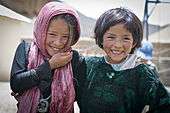Hazaragi culture
|
Part of a series on
|
Hazaragi culture (Hazaragi/Dari: فرهنگ هزارگی) refers to the culture of the Hazara people, who live primarily in the Hazarajat region of central Afghanistan, and the Balochistan province of Pakistan, and elsewhere around the world where the Hazara diaspora is settled as part of the wider Afghan diaspora.
The culture of the Hazara people is rich in heritage, with many unique customs and traditions, and shares influences with Persian, Mongol and various Central Asian cultures.[1][2][3] The Hazarajat region has an ancient history and was, at different periods, home to the Greco-Buddhist,[4] and Timurid civilisations, and later the Ghorid and Ghaznavid dynasties. Later in the early 13th century, the Mongols, led by Genghis Khan, settled in the region. Each of these civilisations left visible imprints on the region's local culture. The Hazara people are descendants of the Mongol peoples who settled in the region in the thirteenth century, which attributes their Mongloid physical features and also the various Mongol influences today present in Hazaragi culture and language. According to genetic evidence, the ethnic group has "patrimonial relations" to Mongol peoples,[5][6] and at the same time is also related to neighboring Persianate peoples thus making them a distinct ethnic group.[7]
The Hazara make up ten percent of Afghanistan's population. Their native Hazaragi language is a variation of the Dari dialect of the Persian language spoken in Afghanistan. The Hazara were traditionally pastoral farmers active in herding in the central and southeastern highlands of Afghanistan. They primarily belong to the Shi'a denomination of Islam, following either the Twelver or Ismaili sects, with a small minority of Sunnis. There has been frequent discrimination against them due to sectarian and ethnic reasons. During the 1940s, the Pashtun dominated government in Kabul implemented a variety of initiatives which sought to Pashtunize the ethnic group and suppress Hazara culture.[8]
Cuisine
See also
References
- ↑ Jochelson, Waldemar (1928) Peoples of Asiatic Russia American Museum of Natural History, New York, page 33, OCLC 187466893, also available in microfiche edition
- ↑ Schurmann, Franz (1962) The Mongols of Afghanistan: An Ethnography of the Moghôls and Related Peoples of Afghanistan Mouton, The Hague, Netherlands, OCLC 401634
- ↑ Mousavi, Sayed Askar (1991) The Hazaras of Afghanistan: An Historical, Cultural, Economic, and Political Study, Oxford University Press, Oxford, England, ISBN 0-312-17386-5
- ↑ Gandhara, Buddhism, About.
- ↑ Genetics: Analysis of Genes and Genomes, Daniel L. Hartl, Elizabeth W. Jones, p. 309.
- ↑ Rosenberg, Noah A. et al. (December 2002) "Genetic Structure of Human Populations" Science (New Series) 298(5602): pp. 2381–85.
- ↑ L. Dupree, "Afghānistān: (iv.) ethnocgraphy", in Encyclopædia Iranica, Online Edition 2006, (LINK).
- ↑ Lansford, Tom (2003). A Bitter Harvest: Us Foreign Policy and Afghanistan. Ashgate Publishing, Ltd. pp. 21–22. ISBN 978-0754636151.
